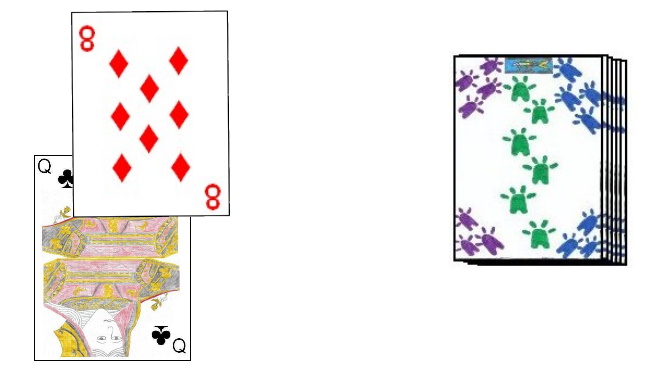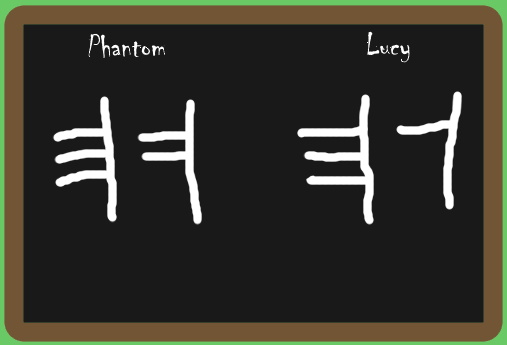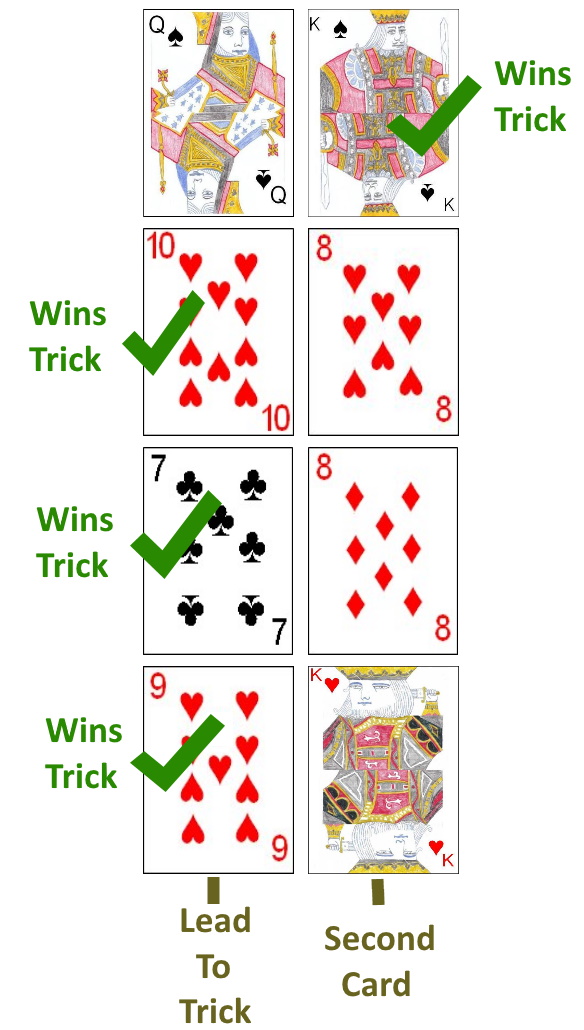Elfern is a very old trick-taking game which originated in Germany and Austria. In German the word "elfern" translates to "making elven", which describes the minimum target score for winning a hand. Elfern is also known under the names Elfmandeln and Figurenspiel. The game is designed for two players and is traditionally played using the classic 32 card German deck. The German pack consists of the cards 7, 8, 9, 10, Unter, Ober, King, Ace in each of four special German suits. If such a traditional German pack is not at hand, it can be created by removing all cards lower than seven from a standard deck. The ranking of the remaining cards in the deck are as follows, from high to low: Ace, King, Queen, Jack, 10, 9, 8, 7.
 |
| During the first phase of a game in Elfern, players are not required to follow suit in playing a card to a trick led by the opponent. |
Once the dealer has been determined and the players seated, the dealer should thoroughly shuffle the cards and offer them to his opponent to cut. After the cut, the dealer then begins dealing the cards, in packets of two cards each, to both players, starting with his opponent. He continues dealing until both players have a total of 6 cards.
The opponent of the dealer (called the forehand), leads the first card to the first trick. The leader to each trick may lead any card still remaining in his hand to start the trick.
The game is actually played in two phases, with the rules for play to an existing trick different, depending which phase of the game is currently in progress. The first phase continues from the first trick until the stock has been depleted. During this first phase, after each trick has been won, both players draw one card from the stock. The winner of the trick draws first followed by his opponent. Once the stock has been depleted, the second phase of the game immediately begins.
During the first phase, after the lead to each trick, the opponent is not obligated to play a card of the suit led to the trick and may play any card from his hand. The trick is won by the highest card of the suit originally led to that trick. The winner of each trick leads the first card to the next trick.
Once the last card from the stock has been drawn, the second phase of the game begins. Obviously during this phase, the players no longer draw cards after each trick is won. Also during this phase, after the lead to a trick, the opposing player is required to play a card of the suit originally led to each trick if he has such a card. If he has no cards of the suit originally led to the trick, he may play any card remaining in his hand. The player of the highest card of the suit originally led to the trick wins the trick. The winner of each trick leads the first card to the next.
The object of each hand is to win the most point scoring cards (called honors). These honors consist of the Ace, King, Queen, Jack, and Ten of every suit. Each of these cards are worth 1 point each as won in a trick. All other cards in the deck have no scoring value. Thus, after every trick has been played and won the players review the cards they managed to capture in tricks during the hand. If either player manages to capture 11 or more points during the hand, he is said to have won the deal (or one game). However, if the player manages to win 15, 16, 17, 18, or 19 points, he wins a double game (two games), in which the opponent is said to be schneider. If one player manages to win every point scoring card during the hand, 20 points, he wins a triple game (three games), in which the opponent is said to be schwarz.

If both players win exactly 10 points during the hand, there is considered to be no winner for that hand (called ständer). The game point to be won for this hand are kept in abeyance, and the winner of the next hand earns the normal game point for that hand as well as the point held in abeyance. If the next game is also a tie, no points are kept in abeyance and the next game is played as normal. As normally, the winner of each hand deals the next, in the event of a tied hand, each player again draws from the shuffled deck with the player drawing the highest card being set as the dealer for the hand.
These Game Points as earned during the course of play are often recorded using a slate and chalk, by drawing a special figures called banners on the slate. For each Game Point won by a player, he adds one line to this banner. Each banner consists of four lines. After completing one such banner, he would then start by drawing another. The first line of each banner is vertical, and the next three of the banner are then drawn horizontally, extending from the vertical line.
After a set amount of time or number of games, the player with the most Game Points as recorded on the slate is declared the overall game winner.
Variations and Optional Rules
Altenburg Scoring: In 1988 a variant scoring system for the game of Elfern was published. The game is played identically to the standard game with the only difference in the number of Game Points which might be scored at the end of each hand. The following chart shows the number of Game Points a player earns based on the number of points earned during any specific hand:
| Honor Points Earned During Hand | Game Points Awarded |
|---|---|
| 11, 12, or 13 | 1 |
| 14 or 15 | 2 |
| 16 or 17 | 3 |
| 18 or 19 | 4 |
| 20 | 5 |
 |
| Several examples of trick play in the game Bohemian Schneider. Notice that only a card in the same suit, exactly one rank higher, can beat the lead card to that trick. |
Similar to Elfern, Bohemian Schneider is traditionally played by two participants using a German suited deck. However, if such a deck is not at hand, a standard French deck can be used which has been reduced to 32 cards. The ranking of the cards in this deck are as follows, from high to low: Ace, King, Queen, Jack, 10, 9, 8, 7.
Determination of seating positions and first dealer can be done in any number of ways, with draw for high card a common method. If both players draw cards of equal rank, they should each draw again, continuing this until both players draw cards that are not of the same rank. The role of dealer in this game alternates amongst the players after each hand.
Once the players are seated and the first dealer determined, the dealer should thoroughly shuffle the cards and offer the deck to his opponent for the cut. After the cut, the dealer then begins dealing the cards, starting with his opponent. He deals each player, two packets of three face-down cards, until each player has a total of six cards. He then places the remainder of the deck, face-down in the center of the table as the talon.
The opponent of the dealer leads the first card to the first trick. In leading to a trick a player may play any card currently remaining in his hand. His opponent may also opt to play any card from his hand. However, he may only win the trick by playing a card in the same suit as led that is exactly one rank higher than the card as led to that trick. For example, the Queen of Spades, led to a trick can only be beaten by the King of Spades. If the opponent is able to play this exact card, he wins the trick and he then leads the first card to the next trick. However, if the opponent is not able (or chooses not) to play this exact card, the leader wins the trick and leads the first card to the next trick. If the talon has not yet been exhausted, each player then draws a card from the top of the talon, the winner of the trick drawing the top card and his opponent drawing the next. Once the talon has become exhausted, the players complete the hand by playing using the remaining cards in the hand.
Once every trick has been played and won, the players then review the cards they managed to win in tricks during the hand. Each player earns one point for each Ace, King, Queen, Jack, and 10 won in tricks during the hand. All other cards have a scoring value of zero. The player managing to win 11 or more points on the hand wins that hand and earns a number of game points based on the specific number of points won. If both players earn exactly 10 points during the hand, neither player wins that hand and no game points are awarded for that hand. If the winner of the hand earns 11, 12, 13, 14, 15, or 16 points during the hand, he earns one Game Point. If he earns 17, 18, or 19 points during the hand he earns two Game Points (schneider), and if he manages to win all 20 points during the hand, he earns three Game Points (schwarz).
After a set number of hands (which should be an even multiple of two to ensure each player has the same number of opportunities to have the first play during a hand), the player with the most Game Points is declared the overall game winner.
Bohemian Schneider Variant Rules: There are several variant rules that are sometimes followed in Bohemian Schneider which can greatly modify the gameplay. The following are some of the most popular:
- In some rule sets, the card led to each trick can be beaten by a card exactly one rank higher of any suit.
- Ordinarily, an Ace, being the highest card can not be beaten by any other card. However, in one variant rule, the Ace can be beaten by exactly one other card, the seven of that same suit.
- Some players prefer to modify the rules to make this game more closely follow the rule in most other trick-taking games. In this variant, the opponent of the player who leads the first card to a trick must play a card of that same suit if they have one in the hand. However, the trick is won by the highest card in the suit originally led to the trick (not just the exact next highest card as in the normal game).